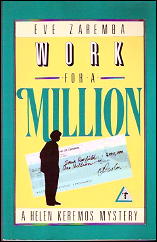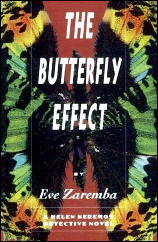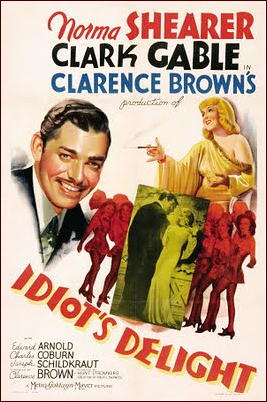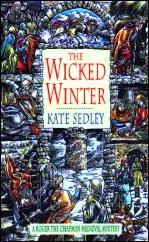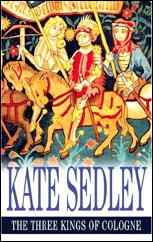May 2010
Monthly Archive
Mon 31 May 2010
A 1001 MIDNIGHTS Review
by Kathleen L. Maio:
EVE ZAREMBA – A Reason to Kill. PaperJacks, Canada, paperback original, 1978. Second Story Press, Canada, trade paperback, 1989.
Even Zaremba’s first mystery surely represents one of the more unusual experiments with the female hard-boiled private eye. First of all, her heroine, Helen Keremos, is a Canadian. Second, she is a lesbian.
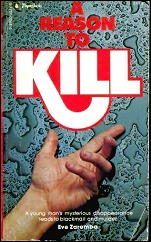
But if the locale of Zaremba’s mystery is obvious, the sexual identification of her sleuth is not. Since Zaremba refrains from chronicling the amorous adventures of her detective, it is only her empathy with male gay characters and occasional name-calling by disgruntled straight men that give her sexual identity away.
Keremos, who operates out of a second-floor walk-up in Vancouver’s Chinatown, is called in by an academic to trace his missing son, last seen in Toronto. With the help of a researcher friend named Alex, Keremos checks out the young man’s past as well as his friends and family — all suspects.
These include his sculptor mother and her drunken lover; a boyhood friend and his masculinity-obsessed father; and an appealing bisexual hood on the edge of Toronto’s entertainment biz. Keremos concludes that Martin Milwell’s disappearance is somehow linked to his recent acknowledgment of his homosexuality, but she must still discover the how and why of his disappearance.
The plot, which seems to be building to an obvious solution, has several twists to deliver before its unusual conclusion — one that turns the classic reenactment of the crime into an exercise in collective decision-making.
Keremos’s cross-Canada trek tells us much about the country and its people as well.
Tough, a navy veteran with plenty of street smarts, Keremos is nonetheless a sympathetic figure. When she takes on two thugs (after a few too many drinks), we may question the realism in the portrayal, but Keremos’ s macho antics are mild compared to most of her male fictional counterparts.
The politics of Zaremba’ s novel, sexual and otherwise, is clearly recognizable as part of the Seventies. For her portrayal of a believable PI, hardboiled and female, Zaremba should be recognized as an early entry in a mystery trend of the Eighties — and very probably beyond.
———
Reprinted with permission from 1001 Midnights, edited by Bill Pronzini & Marcia Muller and published by The Battered Silicon Dispatch Box, 2007. Copyright © 1986, 2007 by the Pronzini-Muller Family Trust.
Editorial Comment: As suggested in my comments following the preceding post, Helen Keremos may be the very first lesbian PI, at least as published by a major publisher (although semi-obscure one). It has been reprinted once, but apparently there’s never been a US edition. (PaperJacks books were generally distributed in this country, however.)
The Helen Keremos series —
1. A Reason to Kill (1972)
2. Work for a Million (1988)
3. Beyond Hope (1988)
4. Uneasy Lies (1990)
5. The Butterfly Effect (1994)
6. White Noise (1997)
Mon 31 May 2010
Posted by Steve under
Reviews[5] Comments
THE BACKWARD REVIEWER
William F. Deeck
DAVID GALLOWAY – Lamaar Ransom–Private Eye. Riverrun Press, Dallas, hardcover, 1979; published simultaneously by John Calder, London, hardcover, 1979 .
For a change, something unusual in private eyes. Lamaar Ransom is hard boiled, a frequent daytime drinker with booze in the filing cabinet, extremely interested in females, especially those who have overdeveloped chests, and given to wise cracks at most unseemly times. Ransom’s secretary is crazy about males.
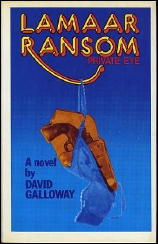
What then, you may ask, is unusual about Ransom? Well, Ransom is a female. Her secretary is Lavender Trevelyan, black, male, gay, and a transvestite. When Ransom wants to borrow some sexy clothes for a disguise, she gets them from Trevelyan.
The director of the Fairfield Academy, dedicated to the training of actresses and models, hires Ransom to find Yvette LaFlamme, no less, who has mysteriously disappeared. The reason Ransom is chosen is because she has tact. Ransom insults her potential client throughout the job interview, forcing one to wonder whether the director knows what tact is.
Perhaps not, since no graduate of the academy has ever been hired as an actress or a model.
Ransom does find the missing LaFlamme, part of her in one suitcase and part of her in another. This leads to additional unpleasantness, even involving Ransom’s lover, a not-very-bright young lady whom Ransom strangely puts in harm’s way by having her enroll at the academy.
A professional’s professional, Ransom, having dyed her hair black — she’s a blonde — in order to impersonate her girlfriend, part Mexican, in a possibly intimate situation, also dyes her pubic hair. It is unlikely that Holmes, Kleek, or Carter, those masters of disguise, were ever that thorough.
The time period of the novel is World War II, and the setting is Hollywood. The ending is deus ex machina, but tolerable.
Aside from wishing that the author had learned how to spell “discreet” and “all right” and had not used “game plan” long before its time, the only anachronism I noticed, my enjoyment of this novel — and whether it is a parody of the private-eye novel I won’t hazard a guess — was considerable.
The cross-talk between Ransom and Trevelyan is alone worth the price of the book. Which, since it has been recently remaindered at $1.98, makes it an even greater bargain.
– From The MYSTERY FANcier, Vol. 10, No. 2, Spring 1988.
Editorial Comments: Since Bill wrote this some 22 years ago, you shouldn’t think that you can find a copy very easily at your local remainder outlet, wherever that may be. It is not too difficult to find online, however, and I just purchased a copy myself.
You should not be surprised to know that this is the only book by David Galloway in Al Hubin’s Crime Fiction IV. It has “one shot” written all over it, but then again I’ve been surprised and been wrong the other way, several times over.
The book — and here I was surprised — was reviewed by Newgate Callendar in the New York Times, and favorably, too. The link works for me, but it may require your registering at the Times website if you haven’t already done so.
Was Lamaar Ransom the first lesbian private eye? Kevin Burton Smith, on his Thrilling Detective website, says no, it was Eve Zaremba’s Helen Keremos, who preceded her by a year.
Mon 31 May 2010
IDIOT’S DELIGHT. MGM, 1939. Norma Shearer, Clark Gable, Edward Arnold, Charles Coburn, Joseph Schildkraut, Burgess Meredith, Laura Hope Crews, Harry Van’s “Les Blondes”: Virginia Grey, Virginia Dale, Paula Stone, Bernadene Hayes, Joan Marsh, Lorraine Krueger. Screenplay: Robert E. Sherwood, based on his own Pulitzer Prize winning play. Director: Clarence Brown.
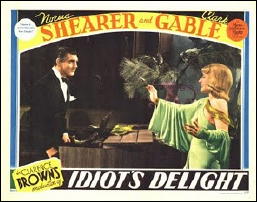
Not only was Robert Sherwood hired to write the screenplay, but he expanded on it by creating a long prelude to the play itself.
Some back story for both of the two stars is filled in, detailing their first encounter as vaudevillians Harry Van and Irene Fellara, whose paths cross and meet again some 20 years later, just as rumors of war are rumbling across Europe.
Clark Gable plays Harry Van, of course, and Norma Shearer is Irene. He’s a stooge for a phoney mind-reader when first they meet, and she’s an acrobat who hangs by her teeth in the act before them. They spend one wonderful night together (but not a bed) before their trains take them in opposite directions in the morning.
Harry Van: [at a train station] Well, we gotta be pulling out now babe.
Irene Fellara: I know, but not together.
Harry Van: No, not together. You go your way and I go mine. But I got a hunch we’ll see each other again. Sometime.
The next time they meet (and of course they do) is in a snowbound lodge somewhere in the Alps.

Unable to cross the border from one country to the next because of international tensions, a large number of passengers from a wide assortment of countries are also stranded.
Harry is now the manager and lead dancer for a troupe of female dancers (Les Blondes). She’s the mistress (we presume) of an important European munitions mogul. She’s also now a blonde and claims to be a refugee Russian countess. His jaw drops.
Irene Fellara: The temple of your memory must be so crowded.
Harry Van: Are you sure you’ve never been in Omaha, Madame?
In fine overdramatized fashion Irene goes into much detail about her former life:
Irene Fellara: And then … an American cruiser rescued me. May Heaven bless those good men!
Harry Van: Ahem. Excuse me Madame. But it seems to me that the last time you told me about your escape it was different.
Irene Fellara: Well! I made several escapes.
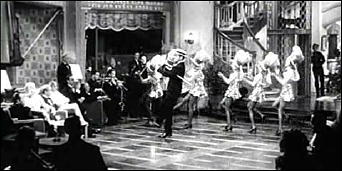
There is a lot of comedy in this film, and in fact it is quite remarkable – I wouldn’t have known it until reading about it later on IMDB – that this is the only time Clark Gable did a song and dance routine in a movie: “Puttin’ on the Ritz.”
He does it well – but then again everything Clark Gable did in a movie he did well. He was, as far as I am concerned, the quintessential Hollywood actor, with a presence before the cameras that was second to absolutely nobody else.
The movie is itself is a time capsule trapped in amber, as Idiot’s Delight is, and you have to watch this movie as if you were in the theater in 1939. It is in itself a plea for peace, not war; laying the blame for the incipient hostilities on munitions manufacturers, unfortunately, not the plans of national glory of Hitler and others. Hitler himself is not mentioned, I do not believe.

So there is a lot of anxiety hidden behind the long-delayed romance and the songs and quick and easy patter of Harry Van.
Lives are about to be disrupted for many and for good. A honeymooning couple are emblems of loves that are (most likely) going to be torn apart.
Many of the people who have left comments seem to feel that the film is outdated, which it is, and corny, which it is and is not, both at the same time. The movie is entertaining, no doubt about it, but watching it in the present day there is a sense of unease or disconnect between its several components, and all I can do is tell you about it. More than this, I haven’t defined it further, no more than I have.
There are two endings for this film. One is a happier one, shown in the US. The other, shown in Europe, which is the one I’ve just watched, ends on a bright note, but one wrapped up in a solid container of reality.
NOTE: Credit for the dialogue quoted goes to the IMDB website, from which I copied and pasted.
Sun 30 May 2010
REVIEWED BY WALTER ALBERT:

TELL IT TO THE MARINES. MGM, 1926. Lon Chaney, William Haines, Eleanor Boardman, Eddie Gribbon, Carmel Myers, Warner Oland. Director: George Hill. Shown at Cinesation 1993, Saginaw MI.
This was a big hit for Chaney, and as in While the City Sleeps (MGM, 1928) it showcases Chaney in a non-horror role. Chaney is a tough sergeant, charged with the unenviable task of whipping unwilling recruit William Haines into shape before the unit ships out.
In both the 1926 and 1928 films, Chaney’s girl is won away by the younger man (criminal he’s trying to reform, recruit he’s trying to save), which allows Chaney to reveal the heart under the crusty exterior.
Superb entertainment, and, according to the notes, was just behind the studio’s Flesh and the Devil! at the box-office. Warner Oland has a small non-speaking role as a Chinese warlord, a role he was playing as early as 1920.
Sat 29 May 2010
Posted by Steve under
General[13] Comments
CHARACTER VS. PLOT IN DETECTIVE FICTION
by Bill Pronzini.
A character-driven detective novel is one in which the plot develops entirely from the people who inhabit it, protagonists and secondary characters both — their psychological makeup, strengths, weaknesses, vulnerabilities, etc. The plot is not created first and the characters inserted to fit the prearranged storyline.
Whodunit, howdunit, detection are all less important than what happens to the people themselves; the impact on them of the crime(s) in which they’re involved; how they and/or the world they live in are altered by these crimes and by other external events, some within their control, some beyond it.
In a character-driven series, the protagonists and those close to them have personal as well as professional lives. And they do not remain the same from book to book; they evolve, change, make mistakes, better their lives, screw up their lives, love, marry, grieve, suffer, rejoice, you name it, the same as everybody else.
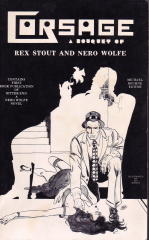
A plot-driven detective novel is just the opposite. Characters are subordinate to plot; the mystery, the gathering and interpretation of clues, the solving of the puzzle are of primary focus and importance. If the detectives have personal lives, they’re generally mentioned only in passing and treated as irrelevent.
This is not to suggest that this type is inferior to the character-driven variety; far from it. I’m a great admirer of the Golden Age writers — Carr (particularly), Queen, Christie, Stout — but their books mostly fall into the plot-first category.
The puzzle, the game is everything. Sir Henry Merrivale, Dr. Fell, EQ, Poirot, Nero Wolfe are all superb and memorable creations, but each remains essentially the same from first book to last. There is no evolution, no significant change. The crimes they solve have no real effect on them, or in other than a superficial fashion on the people good and bad whom they encounter.
One reads their adventures mainly for the cleverness of the gimmicks and the brilliance of the deductions (and in the cases of Wolfe and Archie for the witty byplay, and of H-M for the broad and farcical humor). With the exception of Wolfe and Archie, we never really get to know any of them all that well; and even with that inimitable pair, there are no significant changes in their lives or their relationship with each other.
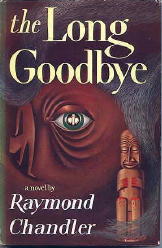
The private eye fiction of Hammett and Chandler is likewise plot-driven (remember Chandler’s oft-quoted remark that when he was stuck for something to happen, he brought in a man with a gun?). The mystery is dominant. As memorable as Sam Spade and the Continental Op and Philip Marlowe are, they’re larger-than-life heroes who remain pretty much the same over the course of their careers.
This is true even in The Long Goodbye, which many consider to be Chandler’s magnum opus (I don’t, but that’s another story); Marlowe’s complex relationship with Terry Lennox and its results, while a powerful motivating force, has no lasting or altering effect on Marlowe’s life.
Ross Macdonald’s novels, on the other hand, are character-driven to the extent that the convoluted storylines devolve directly from the actions past and present of the large casts of characters; but Lew Archer is merely an “I” camera recording events. His life and career remain unaltered by the crimes he solves or any other influences. We hardly know him; he hardly seems real.
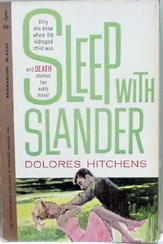
Contemporary private eye fiction tends to be primarily character-driven, in the sense that I used the term above. The cases undertaken by Thomas B. Dewey’s Mac, for instance, evolve from the complexities and eccentricities of the individuals he encounters; crime and violence have a profound effect on him as well as on those individuals, in subtle as well as obvious ways.
The same is true of Hitchens’ Long Beach private eye Jim Sader in Sleep with Slander, a book I’ve called “the best traditional male private eye novel written by a woman.” And of Lawrence Block’s Matt Scudder. And of Marcia’s Sharon McCone (see Wolf in the Shadows, her Shamus-nominated Vanishing Point). And of my “Nameless” series (Shackles, Mourners). All, for better or worse, character-driven and character-oriented. Which is why our readers continue to read us.
Editorial Comment: This essay by Bill is a repost. It first appeared here on this blog on 07 Aug 2007. It has belatedly dawned on me that it fits right in with the ongoing discussion that’s developed here on this blog about author Jane Haddam’s comments on hers about a review of one of her books I wrote and posted on mine about a year ago.
Whew! If this sounds complicated, it is, but if you go here and follow the links and read the comments, some 24 of them at the moment, all will be explained.
[UPDATE] About 15 minutes later. Synchronicity strikes again. I took a few minutes out to see what the the other crime-fiction bloggers have been talking about today, only to discover Ed Gorman reporting on a movie version of Boobytrap in the works, a suspense-filled standalone novel by Mr. Pronzini.
Congratulations, Bill! (And what took them so long?)
[UPDATE #2] 30 May 2010. It was either late last night or my mind suffered a small brain glitch. I really did know better. Here’s Bill’s email to me, received earlier today:
“Thanks for the posted congrats on the Boobytrap film deal. The irony is that it’s a Nameless novel and the first thing the Informant Media people did was to dump him and the rest of the series characters; their only interest was in the basic story, which they’ve also revamped from the novel version.
“Okay with me; I still retain all film rights to Nameless, not that there’s any likelihood he’ll ever appear on a big or little screen. But I suspect that I’m not going to like the film version much. Action films loaded with special effects, explosions, blood and gore leave me cold. But maybe it’ll surprise me.”
Sat 29 May 2010
Posted by Steve under
Reviews[4] Comments
Reviewed by DAVID L. VINEYARD:
BILL PRONZINI – Snowbound. G. P. Putnam’s Sons, hardcover, 1974. Weidenfeld & Nicolson, UK, hc, 1975. Reprint editions: Fawcett Crest, pb, 1975; Futura, UK, pb, 1975; Carroll & Graf, pb, 1994; Stark House Press, trade pb, 2007 (combined with Games).
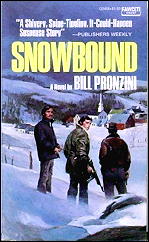
This was the first of many books by Bill Pronzini that I have read, and one whose story and execution has stayed with me for many years. It is almost a model of how to do a closed world suspense novel (i.e. a suspense novel set in a single confined location such as Joseph Hayes Desperate Hours or W.L. Heath’s Violent Saturday) and a perfect blend of action, suspense, and character development.
Hidden Valley is a small isolated mountain town where nothing much happens. This is the story of one week, from December 17th to December 23rd when a snow storm cuts them off from the rest of the world, and the town is enveloped in terror.
Mantled with a smooth sheen of snow, decorated with tinsel giant plastic candy canes and strings of colored lights, the mountain village looked idyllic and vaguely fraudulent, like a movie set carefully erected for a remake of White Christmas. The dark winter-afternoon sky was pregnant with more snow, and squares of amber showed warmly in most of the frame and false-fronted buildings; despite the energy crisis the bulbs strung across Sierra Street shone in steady hues. On the steep valley slopes to the west, south and east, the red fir and lodgepole pine forests were shadowed, white garbed, and as oddly unreal as the village itself.
Likely anyone who has ever been on a ski trip in the Western States has seen this little scene, passed through or visited this little town. It is typical of Pronzini that in so few words he sketches in this familiar setting and yet subtly paints a slightly ominous note — the “dark winter-afternoon sky” and the “vaguely fraudulent” look of the village foreshadow what is to come without any hint of manipulating the reader or forcing his vision.
Zachary Cain, is a newcomer to Hidden Valley. He lives in an A-frame cabin and while friendly enough is something of a mystery. All anyone really knows is he may come from San Francisco and receives a monthly check.
In Sacramento a heist is going down — a big cash-and-carry giant department store is being hit by three men: Brodie, the wheel man, capable and intelligent; Loxner, big and slow witted, not the man they wanted for the job; and, Kubion, the brains, the planner. But the best laid plans as the saying goes … the whole thing goes wrong.
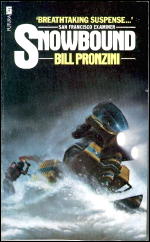
Meanwhile in the valley individuals private lives unknowingly move toward unexpected crisis as their lives are about to spiral out of control.
If you have ever read a suspense novel you know where this is going. Pronzini makes no bones about that as he sets the action up with a kind of grim inevitability that like Hidden Valley is both unreal and achingly true to life. The mark of a great suspense novelist is that ability to let you see what he is doing and at the same time keep you turning the page as the inevitable happens. Pronzini is a master and shows it here.
Like one of those John D. MacDonald novels where a series of disparate people are drawn together toward a moment of violence and crisis Snowbound has an inevitability about it like watching a car wreck happening and not being able to do anything about it. You want to shout out, to warn someone, but no one is listening. No one can hear you, or would listen if they could…
I won’t give away much plot detail. The crooks reach Hidden Valley and a slide closes the only road out of town. Kubion begins to plot how to get out and to take advantage of the situation by effectively holding up the entire valley, aware that they are sitting ducks when the road opens and the police begin to pour in. Meanwhile local tensions grow and the reader begins to sense that pressure like a pot about to boil over. Something has to give…
And give it does in a sudden display of violence, and as the fear and helplessness of the villagers and the brutality and desperation of the criminals dovetail together it becomes increasingly certain that the outsider Zachary Cain is the only man equipped to restore order with his own brand of chaotic violence and his own need for redemption.
Cain, it turns out has something to prove to himself, something to atone for, and maybe if he can save the people of this small village from these three brutal men he can save his own soul.
Along the way Pronzini draws a number of well-etched characters among the villagers with an almost cinematic eye and a few deft strokes of the pen — just enough that their fates matter to us, but not so much that their stories get in the way of the building tension and suspense. That’s a fine line to walk, and it is a tribute to his skill at writing this sort of book that he makes it look effortless.
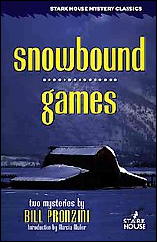
The action is orchestrated like an Alistair MacLean novel, and the suspense rapidly reaches the unbearable level as Kubion goes increasingly blood simple in his desperation and Cain’s growing personal involvement raises the emotional stakes for him.
It is difficult to review a book like this without giving away too much. Let me just say the payoff is both viscerally and emotionally satisfying in the way only the best suspense novels ever manage to be.
The writing, as always with Pronzini’s books, is simple but evocative. Little bits of action or lines that stick in the mind: Kubion rocking in the armored car after the hold-up goes wrong repeating the same words over and over in “a savage litany”; Matt Hughes, a local whose passions will inadvertently set off the violence who suffers from an “almost boyish recklessness”; the people of the village gathered in the local church, “balanced precariously on the edge of panic”; and a dying man as “the black red mist grows and twists through his mind like a helix”.
Parallel with his private eye novels about Nameless (among them some fine examples of the suspense novel within the hard boiled framework), his westerns, anthologies and criticism, Pronzini has continued to write outstanding suspense novels, alone and with Barry Malzberg and others. His skills at this form of story are considerable and have continued to grow, but this one is very close to a blueprint for how this should be done.
And I mean this as the highest of compliments, when you turn the last page you will swear you have seen the movie. That’s something only the best suspense novels achieve.
It was snowing lightly but there was very little wind; the clouds overhead and begun dispersing, and you could see patches of deep velvet sky through the fissures. The storm was nearly over.
Fri 28 May 2010
IT’S ABOUT CRIME
by Marvin Lachman
BILL PRONZINI – Son of Gun in Cheek. Mysterious Press, hardcover, 1987; trade paperback, 1988.
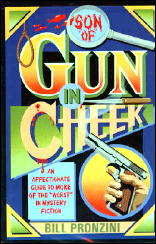
– Reprinted from
The MYSTERY FANcier,
Vol. 10, No. 2, Spring 1988.
Nineteen-eighty-seven was not a vintage year for books about the mystery. There were only eight submitted for Edgar consideration, and they broke no new ground. Yet, in terms of enjoyment many can be wholeheartedly recommended.
There was, first of all, Bill Pronzini’s Son of Gun in Cheek, the even funnier sequel to his 1982 Gun in Cheek (reprinted in 1987 by Mysterious Press in trade paperback), the book which should have won that year’s Edgar.
If you liked Pronzini’s first compilation of inadvertent, but hilariously funny, bad lines from the mystery, you won’t want to miss his second as he takes off after such creators of “alternate classics” as F.M. Pettee, James Corbett, and Michael Avallone.
More famous authors come In for their share of notice, especially when their copy editors let them down. Thus we get lines like the ones quoted from Brett Halliday’s The Violent World of Michael Shayne: “He poured himself a drink and counted the money. It came to ten thousand even, mostly in fifties and twenty-fives.”
There is also a section regarding B movies, especially the old Charlie Chan films. It’s all deftly organized, with some deliberately funny lines by Pronzini himself as a bridge. I read the book on my flight to Minneapolis for Bouchercon and attracted a bit of attention when I couldn’t keep from laughing out loud. Who said scholarship can’t be fun?
Editorial Comments: Here’s another– “The blonde strolled to the cabin and unlocked the door. She went in, leaving the door invitingly open. I looked at it and my red corpuscles began to get redder.” (Milton K. Ozaki, Dressed to Kill.)
Marv used his entire column in this particular issue of The MYSTERY FANcier to cover reference works published in 1987, books about the field of mystery and crime fiction. They (the books) won’t all be as funny as this one, and in fact I can guarantee that none of them will be. I’ll be reprinting these reviews over the next weeks on this blog. Even though Marv’s comments are 22 years old, for the most part they’re far from out of date.
Previously reviewed on this blog:
Gun in Cheek (by Mike Tooney)
Fri 28 May 2010
A REVIEW BY CURT J. EVANS:
FOYLE’S WAR. ITV (UK), PBS (US). “The White Feather.” Season 1, Episode 2. 03 November 2002 (UK date). Michael Kitchen, Honeysuckle Weeks, Anthony Howell; Lisa Ellis, Charles Dance, Maggie Steed, Paul Brook, Tobias Menzies, Mali Harries, Ed Waters. Series creator: Anthony Horowitz.
The second episode of Foyle’s War pits Detective Superintendent Foyle against a group of despicable British Nazi sympathizers. Germany is on the march through the Netherlands and Belgium and into France and the British Expeditionary Force looks doomed.

The Nazi sympathizers meeting at the appropriately named White Feather Inn welcome the German invasion that they think is right around the corner. Then one of them, the inn owner, is murdered, shot during their meeting.
But was she the intended target, or was it the group’s noxious leader, Guy Spencer (played by the splendidly villainous Charles Dance, who also played the awful Mr. Tulkinghorn of Bleak House)? Foyle’s on the job!
I thought the mystery plot in “The White Feather” was quite strong, though the overall story was not as compelling as that in the first episode, “The German Woman” (reviewed here ). There are actually two mysteries in the film, who murdered the inn owner and the whereabouts of a purloined paper, the publicizing of which would greatly embarrass the British government at this critical time. Both are nicely handled.
Viewers should probably be able to guess the murderer (I did!), but the exact mechanics of the crime are very nice indeed, surprisingly more reminiscent of an R. Austin Freeman or John Rhode story than Agatha Christie.
Though I enjoyed the mystery, I was not as drawn into “The White Feather” as I was “The German Woman.” Much of the time is spent with the repulsive Nazi sympathizers, who let us know they are Nazi sympathizers mainly by disparaging Jews at every opportunity. One gets tired of their company very quickly.
There are a couple pf lower class characters we are supposed to sympathize with, a maid and her fisherman boyfriend, but these rather dim characters never make much of an impression, unlike their counterparts, the pub serving girl and shop assistant, in “The German Woman.” Only the thwarted intellectual son of the inn owners really drew my sympathetic attention.
Scripter Anthony Horowitz links the plot to the Dunkirk evacuation, but this almost feels like another film and I didn’t feel like it came off too convincingly. We also meet for the first time Sergeant Milner’s wife, Jane, who tells him she doesn’t want to even see his prothesis leg in their bedroom!
Personally, forced to choose between Jane Milner and the Nazi sympathizers, I might rather spend time with the latter. What a horrid woman. This marriage will not last, I hazard to guess.
Once again the aristocratic types come off rather badly. After the first two episodes in the series, one might conclude that the British aristocracy spent most of its time getting their German wives exempted from internment regulations, when not actually attempting to help facilitate a Nazi invasion.
In real life, while there were Nazi sympathizers among the aristocracy, there were plenty others who weren’t and gave their lives to the fight against the Nazis. Historically, the British aristocracy as a class has served the state in its many wars in large numbers.
This may sound like a lot of carping, but I did enjoy “The White Feather” and would recommend it. It was not up to the top-flight level of “The German Woman,” in my opinion, but it certainly maintained my interest in the series and made me want to see what will happen next!
Fri 28 May 2010
IT IS PURELY MY OPINION
Reviews by L. J. Roberts
Genre: Historical mystery. Leading character: Roger the Chapman, 1st in series. Setting: England–Middle Ages/1522.
KATE SEDLEY – Death and the Chapman. Harper,US, reprint paperback, April 1994. Originally published by Collins Crime Club, UK, hardcover, 1991. Also: St. Martin’s Press, US, hc, 1992.
First Sentence: In this year of our Lord 1552 I am an old man.
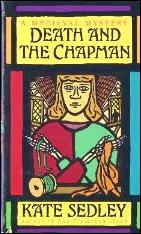
Roger Chapman is 70 years old. As he approaches the last chapter of his life, he decides to write the memoirs of his years spent on the road as a peddler and solving mysteries.
As a young 18-year old, Roger left the Benedictine monastery for the road with London being his objective. His first investigation is into the disappearance of two separate gentlemen and the servant of the second servant while their bags were left behind.
Both men were carrying a good deal of money, but their bodies have never been found. At the same time, the Duke of Gloucester wishes to marry Lady Anne Neville; a marriage opposed by her late husband’s brother. Can Roger do a service to the Royal family?
One of the main reasons I enjoy historical mysteries is that combination of learning and the puzzle. Richard of Gloucester was a figure with whom I was not familiar, yet he achieved positions of tremendous power and responsibility by the age of 19.
I also had not known about “corpsing,” the recovery of bodies from the Thames, their clothing stripped to be sold and the bodies returned to the river. The most interesting element, however, is the character of Roger. Here we meet him both at the beginning of his years; very young and able to be shocked; and see a bit of him at the end of his years.
As long as the later doesn’t too much portend the latter, the stories should hold and allow us to see the character develop over time. Sedley knows her period and know how to bring it alive to her reader. Her descriptions engage your senses; sight, sound and nearly smell.
In fact, there are points where the descriptions nearly overpower the plot. For a first book, the plot is well done although it does rely on some rather large coincidences. I do appreciate it when the author allows that coincidences do happen in life. There is some good suspense at the end, and a satisfying resolution. I did enjoy this book and I look forward to Roger’s next adventure.
Rating: Good Plus.
The “Roger the Chapman” series —
1. Death and the Chapman (1991)
2. The Plymouth Cloak (1992)
3. The Hanged Man (1993) aka The Weaver’s Tale (US)
4. The Holy Innocents (1994)
5. The Eve of Saint Hyacinth (1995)
6. The Wicked Winter (1995)
7. The Brothers of Glastonbury (1997)
8. The Weaver’s Inheritance (1998)
9. The Saint John’s Fern (1999)
10. The Goldsmith’s Daughter (2001)
11. The Lammas Feast (2002)
12. Nine Men Dancing (2003)
13. The Midsummer Rose (2004)
14. The Burgundian’s Tale (2005)
15. The Prodigal Son (2006)
16. The Three Kings of Cologne (2007)
17. The Green Man (2008)
18. The Dance of Death (2009)
19. Wheel of Fate (2010)
Thu 27 May 2010
A REVIEW BY RAY O’LEARY:
JOHN CURRAN – Agatha Christie’s Secret Notebooks. HarperCollins, hardcover, September 2009.
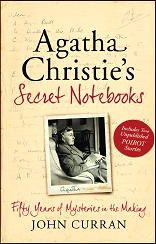
Since John Curran is the literary adviser to the Agatha Christie estate he was allowed to enter the two locked rooms of her house after it was donated to the National Trust and opened to tourists.
The two rooms mostly contained copies and first editions of her various novels, story collections and plays but in the smaller room, on the bottom shelf of a bookcase, he found a cardboard box containing notebooks in which Christie jotted down various story ideas and preliminary plotting for most of her novels, stories and plays.
These notebooks were in no manner orderly; when Christie had an idea she grabbed a notebook at random and jotted it down on the first blank page available. So notes for various of her works are scattered, most of them in more than one notebook and the numbers on them mean nothing as to when she made her entries.
Also, despite what is printed on the dust jacket, none of the notebooks contains any of the plot ideas for The Murder of Roger Ackroyd nor Murder on the Orient Express and a few others of her works. (He never discusses Witness for the Prosecution, play or story, so I’m presuming that might be another.) The notes for those works presumably are lost. What is here is an abundance of ideas used and rejected for most of the things Christie wrote.
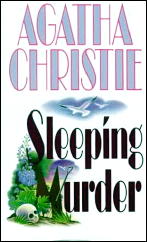
One thing Curran discovered was that the last Miss Marple novel, Sleeping Murder, was written in the late 40’s and not during World War II as previously believed. (Curtain is another book not covered here.)
Sleeping Murder‘s original title was going to be Cover Her Face, but it was changed after P. D. James used that title. The two major finds, however, are unpublished short stories featuring Hercule Poirot, which are printed at the end of his commentary.
The first story was “The Capture Of Cerberus” the 12th Labor Of Hercules. From November, 1939 through most of 1940 the first 11 Labors had been published by the Strand Magazine. It wasn’t until 1947 that she wrote the 12th story which completed the Labors and made possible the collection of that title.
This original story was unsuitable for pretty obvious reasons: It features a character clearly based on Adolf Hitler and portrays him in a favorable light since, in this story, he has a change of heart and becomes a proponent of World Peace, which would have been pretty hard to swallow with bombs falling on London.
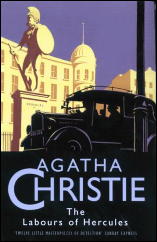
And though Curran doesn’t say so it in his notes, a plot device turns up that was used in Hitchcock’s 1940 film Foreign Correspondent: the kidnapping of a political figure and his replacement by a double who is then assassinated.
The other story is called “The Incident Of The Dog’s Ball.” This is much better, but was never offered for publication because it is a 20 page version of what was to become the novel Dumb Witness (Poirot Loses a Client). Christie must have realized she could easily turn it into a novel so never sent it to her agent.
Finally, if you haven’t read a lot of Agatha Christie’s output and are planning to, be warned: before every chapter Curran states which novels and stories will have their solutions revealed in his discussion.
I finished Christie’s detective novels and stories and some of her plays (she wrote 20) a long time ago so that didn’t bother me. For those who haven’t, you might put off reading this until after you have. Also, Curran uses the politically incorrect (racist) original title for And Then There Were None when talking about that book.
Next Page »

